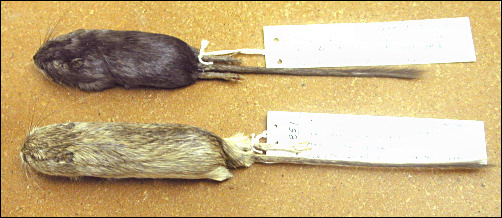

Melanin is a pigment found in the skin, hair, and feathers of animals. One type produces dark brown to black coloration and a different type produces reddish-orange to yellow coloration. In most kinds of animals, individuals or populations appear in which there is more of the dark pigment than is normal for the species. This phenomenon is called melanism and is under genetic control. In some animals, such as black leopards, the coloration appears to be useful under some environmental conditions, and becomes quite common.
In our Southwest, a rather clear case of usefulness is seen in Rock
Pocket Mice living in lava beds. Light colored individuals are easily seen against the
black lava by owls, but dark colored mice blend in nicely. As a result, a number of
lava beds have populations of black mice. Research has shown that black mice of two
different lava beds, although of the same species, have evolved their melanism
independently by different genetic pathways. It just goes to show that there's more
than one way of turning to the dark side.

Contributor: Arthur H. Harris, Laboratory for Environmental Biology, Centennial Museum, University of Texas at El Paso.
Desert Diary is a joint production of the Centennial Museum and KTEP National Public Radio at the University of Texas at El Paso.

Museum specimens of the Rock Pocket Mouse (Chaetodipus intermedius) from Doña Ana County, NM. The dark specimen on top is from the lava bed area; the bottom specimen is not. Laboratory for Environmental Biology specimens, photograph by A.H. Harris.